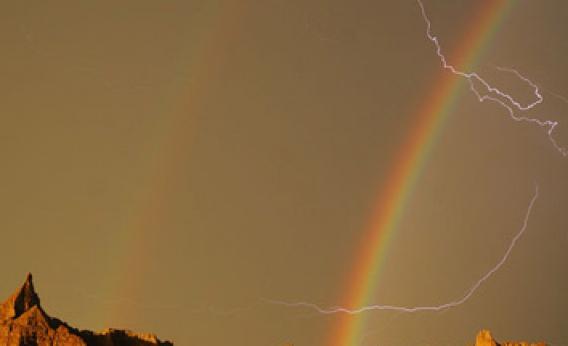Create a free profile to get unlimited access to exclusive videos, sweepstakes, and more!
Double Rainbow, What DoeszZZZZZZZZTTT!

This picture is brought to you by Being at the Right Place at the Right Time With the Right Equipment.
Yes, that’s a double rainbow with lightning inside of it, because why wouldn’t it be?
The photo was taken by Joan Wallner in July 2010. She was driving home from Yellowstone National Park in the Badlands in South Dakota when she saw a storm starting to form. She took some pictures after the storm, which passed as the Sun was setting. Facing east (away from the Sun), the double rainbow appeared, and the dwindling storm decided it would provide the flash for her.
Photographs of rainbows and lightning together aren’t terribly uncommon, but this is one of the best ones I’ve seen. Rainbows form when sunlight passes through raindrops. The light gets bent entering the drop, reflected off the back side, and then bent again as it leaves the front of the drop. The reflection means the Sun has to be behind you to see the rainbow, and the bending separates out the colors (different wavelengths of light bend different amounts).
The most common angle for light to be bent is around 138° (where 180° would mean a perfect reflection of light, so it travels directly back in the direction from whence it came). 180 – 138 = 42, so a rainbow is about 42° in radius. Another way to put it: If you put the Sun directly behind you, so you are facing 180° away from it, the rainbow will form a circular arc 42° from that point.
However, there are other angles the light can come out of the raindrops. If it gets reflected twice inside a drop, it can come out at an angle of 129°, forming a 51° rainbow, outside the primary. The fainter secondary rainbow has the colors reversed (because the light’s reflected twice inside the drops; it’s a reflection of a reflection and the color order reverses). You can see that in Wallner’s photo.
Can you also see how the sky looks brighter inside the primary arc, and darker between them? That’s real, and due to the light reflecting inside the drops as well. Raindrops inside the rainbow’s arc have light coming out of them at angles greater than 138° (closer to the center of the rainbow). At those angles, the colors overlap more, getting mixed together, so the light looks whitish.
The dark band is because drops in that part of the sky take the light and bend it outward toward the secondary arc. They’re removing it from outside the primary arc and putting it in the secondary one, so it looks darker in between them.
Rainbows, it turns out, are actually kinda complicated.
Bottom line, though, is that you need raindrops in the air to see them, and direct sunlight to pass through them. In many locations (like where I live), storms tend to form in the afternoons, when the Sun is low. The wind blows west to east, so the Sun comes out after the storm passes. Rain falling to the east is then illuminated directly, and you get rainbows. Of course, the storm may still be active, and shoot out the odd lightning bolt or two, which is how Wallner was able to snap this amazing photo.
If you like it, she has it available to buy as a print. She has a lot of photos that are quite lovely; go take a look.
And remember: Once a storm passes and the Sun comes out, find a good view in the other direction. You might see something well worth your time to investigate.


























